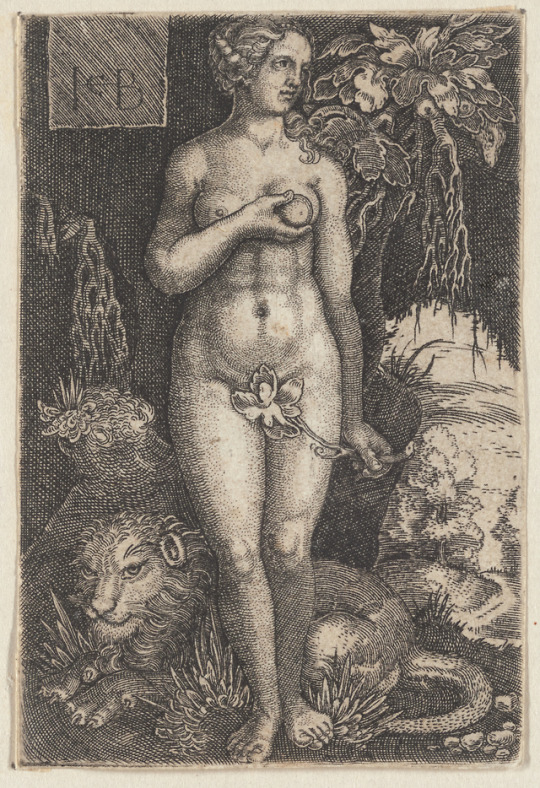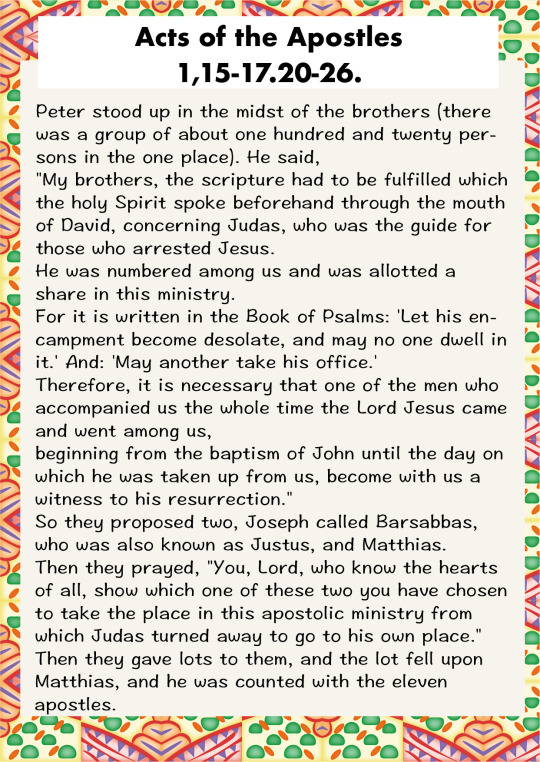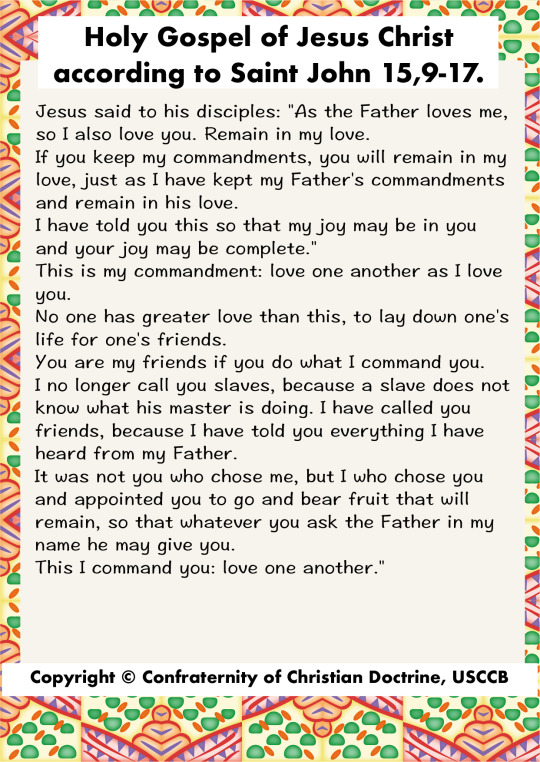#Tertullian (c.155-220)
Text




Readings for 10 June
10/06/2022
#1st book of Kings 19#1st book of Kings#Psalms 27(26)#Psalms#Holy Gospel of Jesus Christ according to Saint Matthew 5#Holy Gospel of Jesus Christ according to Saint Matthew#Tertullian (c.155-220)#Wherever two meet together#Christ is present#God#Lord#Jesus#Holy Spirit#love#hope#heaven#life#peace
1 note
·
View note
Text
Communion in the Hand in the Early Church
My colleague Prof. Elizabeth Klein got a bee in her bonnet about certain traditionalist Catholics claiming that receiving communion in the hand is “an abomination”, and has never been practiced in the history of the Church. As a professor of patristics with a specialization in the history of liturgy, she was frustrated, since the historical record is clear. She typed up the following to make the evidence available.
TL;DR Early Christians definitely received communion in the hand for at least seven centuries. There is no historical question about this issue. The question of what we ought to do today is not the same question as what Christians did in the first seven centuries, but we must avoid sweeping generalizations about what counts as reverent.

Early Christians received communion in the hand at least up until the eighth century. The manner of reception is often described as cupped hands or hands in the form of a cross, and there is remarkable consistency in this detail. Attestations to this are widespread across time and geographical regions. The below represents a selection of these attestations in chronological order; it is by no means exhaustive.
Tertullian (North Africa; c. 155-220): Against Idolatry 7.1; Here Tertullian is chastising Christians who still participate in pagan sacrifices, lamenting that they use the same hands to touch the Eucharist as they do those sacrifices. He asks if they “should put their hands on the body of the Lord with which they have carried the bodies of demons.”
Cyril of Jerusalem (Jerusalem; c. 313-386)*: Mystagogical Catechesis 5.21; “Approaching, therefore, come not with your wrists extended or your fingers open, but make your left hand a throne for your right, which is on the eve of receiving the King. And having hollowed your palm, receive the body of Christ, saying after it amen. Then after you have with carefulness hallow your eyes by the touch of the Holy Body, partake of it, being careful lest you should lose any of it, for what you lose is a loss to you as if of your own members.”
*Note: Some have claimed that this passage is spurious. There is no reason to think so, but the mystagogical catechesis may be falsely attributed to Cyril of Jerusalem and are instead composed by his successor, John. For the purposes of evidence of what early Christians practiced, it makes no difference; the evidence would be from the same place, 50 years later.
Theodore of Mopsuestia (Syria; c. 350-428): Catechetical Homilies 6; “To receive the Sacrament which is given, a person stretches out his right hand, and under it he places the left hand. In this he shows a great fear, and since the hand that is stretched out holds a higher rank, it is the one that is extended for receiving the body of the King, and the other hand bears and brings its sister hand, while not thinking that it is playing the role of a servant, as it is equal with it in honour, on account of the bread of the King, which is also borne by it. When the priest gives it he says: ‘The body of Christ.’ He teaches you by this word not to look at that which is visible, but to picture in your mind the nature of this oblation, which, by the coming of the Holy Spirit, is the body of Christ. You should thus draw near with great awe and love, according to the greatness of that which is given: with awe, because of the greatness of (its) honour; and with love, because of (its) grace. This is the reason why you say after him: ‘Amen.’”
Augustine (North Africa; c. 354-430): In both quotations below, Augustine is pointing out that the Donatists also share the Eucharist with sinful priests (the Donatists argued that sinful priests could not offer valid sacraments).
Answer to the letters of Petillian 2.23.53; “Add to this the fact that I am referring to a man who lived with you, whose birthday festivities you used to frequent with great crowds, to whom you used to give the kiss of peace while celebrating the sacraments, in whose hands you used to place the Eucharist, to whom you in turn extended your hands when he was giving it to you.”
Answer to Parmenian 2.7.13; “Why, then, was he accustomed to offer gifts to God and were others accustomed to accept from him with joined hands what he, blemished and imperfect, had offered?”
Quinisext Council, AKA Council of Constantinople Trullo (Syria; 692): The canon is prohibiting the practice of receiving communion with a vessel rather than one’s hands.
Canon 101 “Wherefore, if anyone wishes to be a participator of the immaculate Body in the time of the Synaxis, and to offer himself for the communion, let him draw near, arranging his hands in the form of a cross, and so let him receive the communion of grace. But such as, instead of their hands, make vessels of gold or other materials for the reception of the divine gift, and by these receive the immaculate communion, we by no means allow to come, as preferring inanimate and inferior matter to the image of God.”
Venerable Bede (England; c. 672-735): In this passage, Bede is recounting the death scene of a certain brother was known for singing scripture verses. He foresees his death approaching although those around him do not.
Ecclesiastical History of England 4.24 “‘What need of the Eucharist? for you are not yet appointed to die, since you talk so merrily with us, as if you were in good health.’ ‘Nevertheless,’ said he, ‘bring me the Eucharist.’ Having received it into his hand, he asked, whether they were all in charity with him, and had no complaint against him, nor any quarrel or grudge.”
John Damascene (Syria; c. 675-749): On the Orthodox Faith 4.13; “Let us draw near to it with an ardent desire, and with our hands held in the form of the cross let us receive the body of the Crucified One: and let us apply our eyes and lips and brows and partake of the divine coal.”
Further questions and clarifications
Did early Christians receive while kneeling?
No. Kneeling on Sundays was forbidden at the Council of Nicaea (325) because at that time it was seen as being related to penance rather than reverence. The below image may help us visualize how early Christians received, although the details about the posture are not as widely attested.
The Rosanna Gospels (Italy; Sixth Century)

This image from a sixth century illuminated manuscript helps us to visualize how communion was received (at least by some) in the early Church. It depicts the Last Supper as a communion line. The disciple at the front of the line first offers thanks to God in prayer with hands raised, then bows and receives in cupped hands very close to his mouth. The other disciples in line tilt their heads in reverent prayer waiting their turn.
Was communion in the hand an exception in the early Church?
The plentiful evidence for communion in the hand means that it was not an exception, but normative. Taken out of context, sometimes certain passages from the Fathers (and later documents) seem to forbid communion in the hand, but they are usually referring to self-communion; i.e. taking the Eucharist oneself from the altar or at home by yourself from a reserve, and not receiving it from the hand of a minister. Self-communion was also allowed in the early Church, but Basil of Caesarea tells us that this practice is to be undertaken only under exceptional circumstances, such as a hermit, or in times of persecution when not everyone was readily able to attend the liturgy (Letter 93).
What about that weird eye thing?
Both Cyril of Jerusalem and John Damascene mention touching the Eucharist to one’s eyes before receiving. The posture in which the Eucharist was received in the hand may help explain this custom of reverence. As in the image above from the Rosanna gospels, the communicant is bowed with cupped hands to receive, and his hands are very close to his eyes. One could imagine passing these cupped hands over one’s eyes before receiving without physically touching the Eucharist.
However, we also have to keep in mind that reverence and understandings of reverence do change over time. Augustine, for example, mentions a miracle involving putting the Eucharist on someone’s eyes, which healed them (Unfinished Work Against Julian 3.162). He neither approves nor censures the mother who used the Eucharist in this way. Although we have no reason to think that this was a common practice, we would not consider that appropriate today nor seek to use the Eucharist for medicinal purposes. There is no golden age of the liturgy to which we should aim to return. Liturgical reforms, including signs of reverence, require sensitivity both to the tradition and to the needs of the modern church.
Did the Church totally reject this practice at some point?
Practices evolved in both East and West such that receiving directly on the tongue / into the mouth was normative. These changes are related to reverence, but the chief concern is the prevention of dropping or spilling – patens and unleavened bread in the West and spoons, drop cloths and tincture in the East both minimize Eucharistic mishaps. The prevention of spilling/dropping was also a chief concern of the Fathers in their recommendations, as mentioned in some of the citations above. However, the Church does not seem to have ever forgotten these earlier roots and practices of receiving communion. Take the following for an example.
In a vision recorded in the Passion of Perpetua and Felicity (North Africa; 3rd century), where Perpetua receives a piece of cheese from Jesus in paradise continued throughout the centuries to be identified as Eucharistic because of the way she received it, in cupped hands.
Pope Benedict XIV (Rome; 1748) interprets Perpetua’s reception of the cheese as a kind of miraculous reception of the Eucharist prior to martyrdom because it is called in Latin a buccella (morsel) and eaten reverently (On the beatification of the servants and canonization of the Blessed vol. 3, p. 180): “It is certain that in this vision one can discern a sketch of the Eucharist; in the morsel offered to Perpetua and in reverent accepting and eating of it and in the voices surrounding saying ‘Amen.’” (It should be noted that Pope Benedict specifically notes that “ipsa accepit junctis manibus”, that she received it with joined hands, which, as Dr. Klein notes, he describes as reverently receiving it.)
46 notes
·
View notes
Photo

The Fall
The first woman saw that the forbidden fruit of the tree of knowledge “was good for food and pleasing to the eye, and also desirable for gaining wisdom.”
She took some and ate it, and also gave some to her husband. “Then the eyes of both of them were opened.”
The influential Christian theologian Tertullian (c. 155/160-220 CE) twisted this to assert that all women share Eve's "ignominy...of original sin and the odium of being the cause of the fall of the human race."
The die was cast. During the Middle Ages, the (virgin obsessed) Saint Bernard of Clairvaux, blamed Eve as "the original cause of all evil, whose disgrace has come down to all other women."
The above engraving, accessed from the New York Public Library, was made by Jacob Binck in the 16th century.
1 note
·
View note
Text
The spiritual offering of prayer
From the treatise On Prayer
by
Tertullian, priest
[ c. 155 - 220 A.D. ]
Prayer is the offering in spirit that has done away with the sacrifices of old. What good do I receive from the multiplicity of your sacrifices? asks God. I have had enough of burnt offerings of rams, and I do not want the fat of lambs and the blood of bulls and goats. Who has asked for these from your hands? What God has asked for we learn from the Gospel. The hour will come, he says, when true worshippers will worship the Father in spirit and in truth. God is a spirit,and so he looks for worshippers who are like himself. We are true worshippers and true priests. We pray in spirit, and so offer in spirit the sacrifice of prayer. Prayer is an offering that belongs to God and is acceptable to him: it is the offering he has asked for, the offering he planned as his own. We must dedicate this offering with our whole heart, we must fatten it on faith, tend it by truth, keep it unblemished through innocence and clean through chastity, and crown it with love. We must escort it to the altar of God in a procession of good works to the sound of psalms and hymns. Then it will gain for us all that we ask of God. Since God asks for prayer offered in spirit and in truth, how can he deny anything to this kind of prayer? How great is the evidence of its power, as we read and hear and believe. Of old, prayer was able to rescue from fire and beasts and hunger, even before it received its perfection from Christ. How much greater then is the power of Christian prayer. No longer does prayer bring an angel of comfort to the heart of a fiery furnace, or close up the mouths of lions, or transport to the hungry food from the fields. No longer does it remove all sense of pain by the grace it wins for others. But it gives the armour of patience to those who suffer, who feel pain, who are distressed. It strengthens the power of grace, so that faith may know what it is gaining from the Lord, and understand what it is suffering for the name of God. In the past prayer was able to bring down punishment, rout armies, withhold the blessing of rain. Now, however, the prayer of the just turns aside the whole anger of God, keeps vigil for its enemies, pleads for persecutors. Is it any wonder that it can call down water from heaven when it could obtain fire from heaven as well? Prayer is the one thing that can conquer God. But Christ has willed that it should work no evil, and has given it all power over good. Its only art is to call back the souls of the dead from the very journey into death, to give strength to the weak, to heal the sick, to exorcise the possessed, to open prison cells, to free the innocent from their chains. Prayer cleanses from sin, drives away temptations, stamps out persecutions, comforts the fainthearted, gives new strength to the courageous, brings travellers safely home, calms the waves, confounds robbers, feeds the poor, overrules the rich, lifts up the fallen, supports those who are falling, sustains those who stand firm. All the angels pray. Every creature prays. Cattle and wild beasts pray and bend the knee. As they come from their barns and caves they look out to heaven and call out, lifting up their spirit in their own fashion. The birds too rise and lift themselves up to heaven: they open out their wings, instead of hands, in the form of a cross, and give voice to what seems to be a prayer. What more need be said on the duty of prayer? Even the Lord himself prayed. To him be honour and power for ever and ever. Amen.
0 notes
Photo




Readings for 14 May
14/05/2021
#Acts of the Apostles 115-17.20-26#Acts of the Apostles#Psalms 113(112)1-2.3-4.5-6.7-8.#Psalms 113(112)#Psalms#Holy Gospel of Jesus Christ according to Saint John 159-17.#Holy Gospel of Jesus Christ according to Saint John#Tertullian (c.155-220)#Saint Matthias apostle one of the twelve foundation stones of the Church (Rev 21:14)#God#Lord#Jesus#Holy Spirit
4 notes
·
View notes